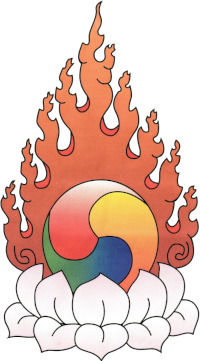Bhutan, is officially called the Kingdom of Bhutan. It is bordered to the north by Tibet and to the south, east and west by India. In 2006 Bhutan was designated the eighth-happiest country in the world and the happiest country in Asia. Bhutan’s state religion is Vajrayana Buddhism. Buddhism was first introduced to Bhutan in the 7th century AD. by Tibetan king Songtsän Gampo, a convert to Buddhism. King Gampo extended the Tibetan Empire into Bhutan and Sikkim and built several important Buddhist temples.
At the beginning of our trip, we will visit the “108 Stupas” at Douchu-la. We will also spend time exploring the Chimi Lhakhang also known as Drukpa Kuenley Lhakhang. The Chimi Lhakhang is situated on a hillock in the center of the valley, and is dedicated to Lama Drukpa Kuenley This Lama, nicknamed ‘The Divine Madman” lived in the late 15th century, and was known to have used humor, songs and outrageous behavior to dramatize his teachings. In this area we will also be visiting the ruins of Wangdu Dzong and Tsongsa Zong.
Our next stop on our trip shall be the town of Bhumthang, where we will visit:
Jambay Lhakhang: This monastery was built in the 7th century by the Tibetan King, Songtsen Gampo. It is one of the 108 monasteries built by him to subdue evil spirits in the Himalayan region.
Kurje Lhakhang: Situated in front of Jambay Lhakhang, Kurje Lhakhang consists of three temples. The one on the right was built in 1652 on the rack face where Guru meditated in the 8th century. The second temple is built on the site of a cave containing a rock with the imprint of Guru’s body and is therefore considered the most holy. The third temple was built in 1990s by Ashi Kesang, the Queen Mother. These three temples are surrounded by a 108 chorten/stupa wall.
Tamshing Lhakhang: Located across the river from Kurje Lhakhang, this temple was founded in 1501 by Terton Pema Lingpa, the re-incarnation of Guru Padsambhava. The monastery has very ancient religious paintings like 1,000 Buddhas and 21 Taras (Tara is the female form of the Bodhisattva Avaloketeshvara). The temple was restored at the end of the 19th century.
Jakar Dzong: Founded by the great grandfather of the first Shabdrung, the Dzong was initially built as a monastery in 1549. It was expanded after the Shabdrung had firmly established his power in 1646.
Konchogsum Lhakhang: This Lhakhang was built in the 6th century but was renovated in 1995, which accounts for its fresh look. It contained a large bell. It was said that when this bell was rung, it could be heard all the way to Lhasa, Tibet. The bell is now displayed at the National Museum in Paro.
Chankhar Lhakhang: This is the site of the palace of the Indian King Sindhu Raja. Because of its simplicity it looks like an ordinary village house. The original palace was built of iron and this is why it was named Chankhar, which means iron castle. It was rebuilt in the 14th century by a Saint named Dorji Lingpa.
Lhodrak Kharchhu Monastery: This monastery was founded by Namkhai Nyingpo Rinpoche in 1984 who was recognized at a very young age by H.H. the 14th Dalai Lama and H.H. 16th Karmapa as the reincarnation of an important Tibetan lama whose spiritual lineage dates back to the 9th century. The monastery now houses nearly 400 monks and has become part of an extensive effort to preserve and revitalize Tibetan culture.
Now back in Thimphu, we will visit the National Memorial Stupa, and then drive on to the Changangkha Temple where we can offer prayers. This is a 14th century temple situated on a small hill top overlooking Thimphu Valley. We will then visit the Zoo to see the National Animal TAKIN and the Zilukha Nunnery. There at the nunnery, we can make offerings of butter lamps and meet the nuns. After lunch we’ll visit the Trashichhodzong and the Kuenselphodrang from where we can view the Buddha Point. This is a wonderful vista of the biggest Buddha statue in the world, situated on a hilltop with a panoramic view. We will also visit a handicrafts emporium, a school of paintings, the Thimphu Tibetan Medical Museum, and Medicine Centre, and the National Library.
We next arrive in Paro, to visit Taktsang, which is also known as “The Tiger’s Nest”. We will hike up to Taktsang to visit the oldest monastery in Bhutan built by Guru Padmasambhava. Later in the day, we’ll visit Ta-Dzong, Bhutan’s national museum. If time permits, we will visit Kyichu Lhakhang, another old monastery, built in the 7th century by King Thrisongdetsen and Dungtse Lhakhang.
After we arrive back in Delhi, we will drive to Agra for a day trip to visit the Taj Mahal, one of the Seven Wonders of the World. The Taj Mahal was built by Emperor Shah Jhan as a memorial and tribute to his beloved wife Mumtaz Mahal.
In addition, we may have opportunities to receive teachings from recognized Buddhist teachers and Rinpoches while in Bhutan.
The price will be all-inclusive (lodging, meals, and local transportation) within Bhutan & India from September 27th through October 8, 2015.
The price includes a donation of $1000 per person to the Jewel Heart Organization, which is tax deductible to the extent permitted by law.
The price for “Pilgrimage to Bhutan and India Tour” package does not include international airfare.
|
Lodging |
Single |
Per person for Double accommodation rate |
|
$6,400.00 |
$5,750.00 |
The package rate is based on a minimum of 20 persons for this trip.
If Gelek Rimpoche’s health permits, he may be able to join in this trip. It is always possible that health considerations could limit his participation during the trip.
All participants are expected to purchase their own health insurance and trip cancellation insurance, and will be asked to sign a waiver.
Contact: [email protected] Phone (734)994-3385
You can also visit: https://sites.google.com/site/jhpilgrimagebhutantajmahal2015/home


